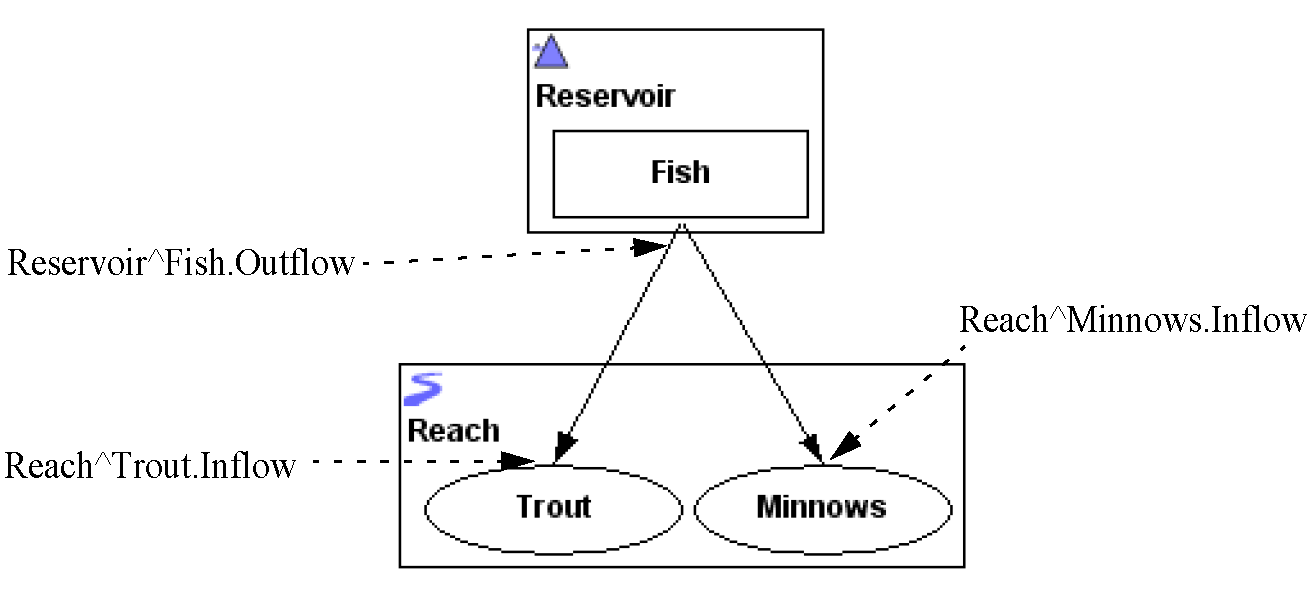About Supplies
Accounts, defined on the simulation objects, track water as it moves through the network. Accounts are connected to other accounts by an entity called a Supply.
Supply A supply links two slots on two accounts. Specifically, a supply to an account means that paper water is transferred into that account from another (often upstream) account. |
The term supply comes from the relationship between the two accounts. The account on the upstream end of the link supplies the downstream account with water. Similarly, the downstream account has a demand on the upstream account. When looking at a given account, there may be supplies coming into the account and demands leaving the account. We can also say that there are supplies to the accounts and that the account has demands. The demand to one account is also considered a supply to the downstream account. As a result, we refer to all of the links in the accounting system as Supplies.
Supplies are workspace objects, like a Storage Reservoir or Reach simulation objects. Because they are workspace objects, supplies are referenced by RPL using a different syntax than simulation slots. This syntax used to reference a supply is “SupplyName.Supply”. This is described in more detail in later chapters.
Typically, there are multiple supplies both entering and leaving an account. Supplies can connect two slots on the accounts on the same simulation object or on other simulation objects as long as there is a physical simulation link between the two objects. In addition, there may be multiple supplies connecting the same two accounts.
Supply Names
By default, the supply name indicates the from object, the from account, the text “to”, the to object, and to account. For Diversion/Return Flow and Transfer supplies (see next section), the string “Div” and “Tran” are appended, respectively.
The format for supply names can be controlled by the user in the Supply Name Format dialog. (See Supply Name Format for details.) The format specified in this dialog is applied to new supplies and can be applied to existing supplies from the Supply Manager. The user can also individually set supply names from the Open Account dialog Supplies tab. See Configuring Individual Accounts for additional information.
Types of Supplies
When a supply is created, the user must select how the supply is going to be used. In the supply creation menu, the user can select one of the following supplies classifications. The selected type determines which slots will be linked.
Note: A link in the physical or simulation system must exist to create a supply between two accounts.
Inflow/Outflow
A supply connecting an inflow on an account on one object and an Outflow on an account on another object. These are used to represent the water that is moving from one object to another as an outflow to an inflow. The supply is created from the downstream account to the upstream account.
In Figure 1.1, an Inflow/Outflow supply connects the following:
Reservoir^Fish.Outflow to Reach^Trout.Inflow and Reservoir^Fish.Outflow to Reach^Minnows.Inflow
Figure 1.1 Inflow/Outflow example

Diversion/Return Flow
A supply connecting a Diversion (or Return Flow) on an account on one object to a Diversion (or Return Flow) on an account on another object. These supplies are used to represent water that is diverted from one object to another. They are also used to represent return flows from one object to another. A supply connecting Diversion slots is created starting at the receiving object, typically a water user. A supply connecting Return Flow slots is also created by starting at the receiving object, in this case, it is usually the reach or reservoir object.
In Figure 1.2, a Diversion/Return Flow supply connects the following:
Reservoir^Project.Diversion to Farms^AppleOrchard.Diversion and Farms^AppleOrchard.ReturnFlow to Reservoir^Project.ReturnFlow
Figure 1.2 Diversion/Return Flow example

Transfer
A supply connecting a Transfer In on an account to a Transfer Out on another account on the same object. These supplies are used to represent water that is transferred from one account to another on the same object. The supply is always created starting at the receiving account, the one that is receiving the Transfer In.
In Figure 1.3, a Transfer type supply connects the following:
Reservoir^Project.Transfers Out to Reservoir^Fish.Transfers In
Figure 1.3 Transfer type supply example

Supply Properties
Accounts have optional Water Type and Water Owner properties that can be used to classify and label the accounts. Similarly, Supplies have properties that can be used to label the purpose and/or classify the account. These optional properties are called Release Type and Destination Type and are described as follows:
Release Type
Supplies can be labeled according to their release type. For example, a release may be made for environmental flow purposes.
Destination Type
In addition, supplies can be labeled according to their Destination Type. For example, a release may be made from a reservoir to be used at a downstream water user.
Thus, using the Release Type and Destination Type properties, the user can specify both the reason for releases and where the water is ultimately headed. For example, a release might be made for flood control purposes but can also be diverted downstream for use in a groundwater recharge structure.
The Release Type and Destination Type are defined in the Accounting System Configuration and apply to a specific model. When configuring an individual supply, the default Release Type and Destination Type is NONE but can be changed by the user.
Setting Values With a DMI
If a DMI is used to bring in values to account inflows, outflows or transfers, it should set supplies in the accounting system rather than accounting slots. This is similar to the concept of setting supplies with rules; see Setting Slots Versus Setting Supplies for details.
Revised: 06/04/2022